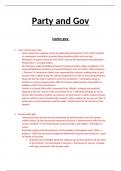Party and Gov
Lenin gov
Party control over state
- Lenin refused to recognise results of nationwide election Nov 1917 (which resulted
in subsequent constituent assembly being abolished after only one day)
- Refused to recognise elections May 1918 + banned all other parties (including SRs +
Mensheviks) + arrested leaders
- Key decisions made by Politburo (head of Communist Party which consisted of ~40
powerful Bolshevik members, incl powerful figures such as Trotsky, Stalin, Kamenev
+ Zinoviev) Sovnarkom (which was supposedly key decision making body of gov)
became mere rubber stamp for policies proposed by it (with its decreasing influence
shown by the fact that it started to meet less frequently + eventually ceased to
function as centre of government AND 1919 Secret police became responsible to
politburo rather than Sovnarkom)
- Soviets at all levels filled with Communist Party officials, bringing state political
apparatus into the control of the Communist Party + ultimately bringing an end to
democratic centralism (bottom up structure of governance in which ordinary people
express wishes at local level (through Soviets), which would work its way up chain of
governance so that decisions could be made + implemented in the interests of the
people)
Bureaucratic elite
- Communist Party quickly became dominated by administrators from the former
middle classes (as they possessed important technical + administrative skills that the
country needed) not empowering common workers and soldiers, still elitists in
power
- Especially evident with development of Nomenklatura throughout early 1920s, a
group of ~5500 key personnel assigned by Bolsheviks to government posts on a basis
of loyalty to the party
Enjoyed many privileges denied to ordinary ppl, eg even during civil war lived
in the Kremlin + the best hotels in Moscow + had access to saunas, hospitals
and huge restaurants with foreign cooks
, Political repression
- Willing to use force against non-party members
CHEKA created shortly after Oct revolution to target class enemies
o SRs, Mensheviks, anarchists + other extreme left wing groups arrested
en masse (5000 Mensheviks 1921)
o ~300,000 prisoners shot in cities for ‘counter revolution’
1921, Union of Militant Godlessness established to challenge church
o 1922, given orders to strip church of precious items
o Violent clashes with clergy + local people and hundreds of priests
executed
1922, Red army harshly dealt with peasant revolt
o Tambov region swarmed with Red Army troops + whole rebel villages
destroyed in brutal campaign involving the use of poison gas to flush
out rebels hiding in the forests
- But unwilling to use force against party members, using non violent means of
‘purging’ them from the party
1921, non violent purges of Communist Party in ‘chistkas’ removed
‘undesirable’ elements + withdrew party membership
Centralising power within the party
- Although Party contained many powerful leaders + most of authority was
concentrated into their hands, party nevertheless was an organisation in which many
ppl had influence + power, rather than just Lenin
Eg Stalin had a number of highly influential posts, incl
o General Secretary (Head of Secretariat, interpreted + implemented
politburo’s decisions and responsible for various branches of Party
Bureaucracy)
o Head of Central Control Commission (created to eradicate corruption
within party + had power to expel party members)
o Commissar for Nationalities (responsible for overseeing affairs of all
non-Russians – 50% of pop – and communicating with senior officials
across Soviet Union)
Trotsky Commissar for war in Sovnarkom, making him commander of army
(huge power) lots of influence + operated largely independently of Lenin
to quash counter revolutionary threat during civil war 1918-21
Bukharin had unofficial role of Party theorist (responsible for all city
newspapers + had huge control over the party press)
Party discussion
, - Lenin passed a resolution at tenth party congress 1921 which banned speaking out
against party policy in organised factions once it was decided (with penalty being
expulsion from the party)
- Instances when Lenin did not consult party over highly important matters + used
influence to impose decisions on them (for example approved Treaty of Brest-Litovsk
1918 + threatened to resign as party leader to force others to accept)
- Ban on factions implemented lightly, eg 10th Party Congress of 1923 NEP hotly
debated, with the ‘left-opposition’ attacking curbs on gov spending and arguing that
peasants should pay more for consumer goods
- Lenin arguably generally followed the will of the party (for example with radical
policies such as the Land Decree Oct + Decree of Worker’s Control Nov 1917, policies
such as war communism to win the civil war, and policies such as NEP to help Russia
recover from the civil war)
- Genuine debate + discussion at top level of Party, with Lenin adopting semi collective
leadership and working alongside other senior figures (eg politburo met weekly
throughout 1920s)




